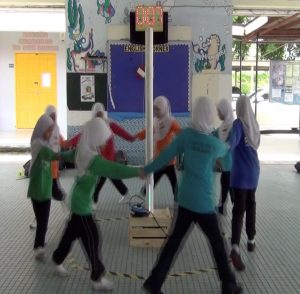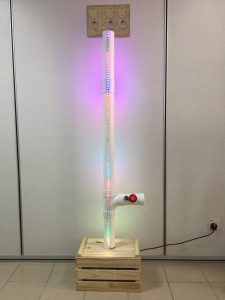Augmenting Circle Dance with Physical Computing to Encourage Empathy among Schoolchildren
– Headed by Dr Hanif Baharin.
Mimicry and synchrony of movement have long been used in dance and songs by many cultures to strengthen social cohesion. Pusing Tiang (Malay; loosely translated as Round-a-Pole) is an installation that augments circle dance by turning it into a game. It was pilot tested in a school among 16 primary schoolchildren. The results show that the installation encourages schoolchildren to synchronise their movement through play. Pusing Tiang’s program has received copyright. It has also been accepted in the curated art installation stream at the premier international conference of Human-Computer Interaction, the 2019 ACM CHI Conference on Human Factors in Computing Systems (CHI). CHI is also ranked the fourth in conference among all disciplines by Microsoft Academic Ranking.
Introduction
Pusing Tiang is an interactive art installation inspired by circle dance – a form of dance practiced in almost every culture. Human culture have long leveraged upon mimicry and synchrony of movement through dance and songs to foster social cohesion. As a gamification of circle dance, it is designed to fulfil the following design criteria, which fits into the context of Malaysian primary schoolchildren’s playing behaviour during recess:
- Games may be designed as variations of previously known and popular games among schoolchildren.
- Games may be designed to be played for 15 to 20 minutes, which is the time the schoolchildren have to play after their meal during recess.
Pusing Tiang (Round-a-Pole)
Pusing Tiang (Figure 1) consists of a base made from IKEA wooden box, which contains Arduino board and a motion sensor. A pole made of PVC pipe is erected from the centre of the box. LED strips are attached at two sides of the pole (Figure 1 only shows LED strip on the front side). At the top of the pole there is a timer.
To play Pusing Tiang, schoolchildren have to hold their hands and make a circle around the pole. To start the game, one of them have to press the red start button, and the timer would start a countdown. Once the countdown ends, the timer starts, and the schoolchildren can start moving in circle around the pole whilst holding hands, like playing round-a-rosie.
Figure 1: Pusing Tiang is made using ready-made materials to enable inexpensive replication.
A trigger of the motion detector will light up one LED light starting at the base of the LED strips. As Pusing Tiang detects more movement, more LEDs will light up until it reaches the top of the pole. The faster the children move around Pusing Tiang, the faster the LEDs will light up and reach the top. The game ends when all the LEDs on the strips are turned on. The timer will display the time the players took to turn on all the LEDs on the strips. A knob next to the start button controls the difficulty level of the game. A low difficulty level requires less movement detection to light up all the LEDs compared to a high difficulty level.
Findings
The pilot test shows that Pusing Tiang gameplay enforces the schoolchildren to coordinate their movements with their co-players in order to move fast around the pole without letting go of their co-player’s hands. It was observed that if the players synchronised their movements, they can light up the topmost LED faster and end the game. This means that the design is successful in enforcing the function of circle dance to create mimicry in movement and synchrony. It took about one minute and five seconds at the lowest difficulty level for the fastest group to end the game. However, the schoolchildren have to be coached about how to synchronise their movements.


